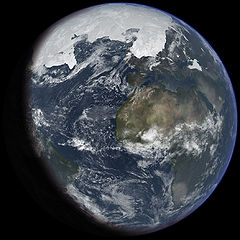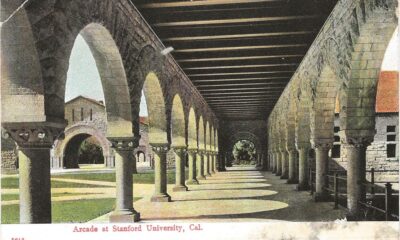Creation Corner
Post-Flood Ice Age: a model

Last year Dr. Larry Vardiman showed several major storms would have been much stronger soon after the Global Flood. They would have showered the Middle East with much more rain, and North America with much more snow. This precipitation, and the higher winds that would have prevailed, would explain the great Ice Age. Larry Vardiman made only one error: he assumed his favorite Global Flood model would have released the right amount of heat.
Vardiman explains his Ice Age model
Dr. Vardiman presented his findings on December 18, 2014, at the Apologetics Symposium, a monthly program of the Northwest Creation Network. He used the Weather Research and Forecasting Model to simulate several recent known storms in the Western Hemisphere and the Middle East:
several winter storms traveling across Yosemite and Yellowstone National Parks, two tropical storms originating in the Caribbean Ocean, two tropical cyclones in the Arabian Sea, and three nor’easters on the East Coast of North America.

An artist’s concept of Earth during the Ice Age. Graphic: User “ittiz” on Wikimedia Commons, CC BY-SA 3.0 Unported License
First he ran the simulations under the original conditions. The simulations agreed well with the real histories of those storms.
Then he ran the simulations again, after assuming the oceans were ten kelvins warmer. (One “kelvin” is one degree Celsius or 1.8 degrees Fahrenheit.) The simulated winds blew much harder, and as much as six times as much rain (and snow) fell. The tropical cyclones became “hypercyclones” and followed radically different tracks. The nor’easters became more intense. (Think of Hurricane Sandy in 2012.)
In addition, intense regional-scale, counter-clockwise, low-level circulations developed on the East Coast of North America and over the Middle East.
In sum, warmer oceans produce worse weather. Bad enough on that scale to make an Ice Age. That includes enough snow in North America to produce the glaciers that once flowed.
What made the contrast?
[ezadsense midpost]
Walter T. Brown, of the Center for Scientific Creation, examined the Ice Age problem long ago. An Ice Age, he says, needs warm oceans and cold lands. Water evaporates from those warm oceans. Make them warm enough, and high winds blow. When this water passes over a colder land, it precipitates as rain. Or, over cold-enough land, snow.
Brown has long criticized the Catastrophic Plate Tectonic Theory by Vardiman, John R. Baumgardner, and four other workers. Instead he offers his Hydroplate Theory, most famous for describing a subcrustal ocean that broke containment where the Mid-Oceanic Ridges now stand.
The Hydroplate Theory assumes the earth’s core heated after the fragments of the original land mass settled into the earth from gravity. More than that: the continents immediately settled at a much higher level than they have today. They also had compressed from that settlement. But at that great height, cold air prevailed, much colder than today. The oceans, with floors much closer to the now liquid magma, had higher temperatures. High enough to produce the high winds, rains, and snows Vardiman found in his simulations.
The continents then sank further, especially at the new mountain chains that formed. As they sank, the ocean floors rose, especially at the Pacific Basin. This raised sea levels and washed out land bridges, especially the bridge over the Bering Straits.
The Catastrophic Plate Tectonic Theory says the Pacific plate dived beneath the surrounding plates. This “runaway subduction” caused the oceans to wash over the continents, producing the Global Flood. It also, so the theory says, turned over the magma to release extra heat.
Brown points out an insurmountable problem. That kind of turnover, even if those processes could take place, would release too much heat. The oceans would still be much warmer than they are today.
But the key to the Ice Age is not the warmth of the oceans but the contrast between warm oceans and cold lands. Brown suggests two influences enhanced the contrast. The magma heated the oceans. (And probably still does, to make the El Niño weather makers of today.) The higher, hence colder, continents precipitated the clouds from those oceans.
Reprinted from examiner.com
[ezadsense leadout]
Terry A. Hurlbut has been a student of politics, philosophy, and science for more than 35 years. He is a graduate of Yale College and has served as a physician-level laboratory administrator in a 250-bed community hospital. He also is a serious student of the Bible, is conversant in its two primary original languages, and has followed the creation-science movement closely since 1993.
-

 Civilization2 days ago
Civilization2 days agoDC Pipe Bomb Arrest Raises Questions About Christopher’s Wray’s FBI
-

 Civilization5 days ago
Civilization5 days agoYoo Hoo, VP Vance—Your Character is Showing!
-

 Executive5 days ago
Executive5 days agoThe Last Supper: New York’s Socialist Feast
-

 Guest Columns4 days ago
Guest Columns4 days agoCongressional Leaders See Far Higher Stock Returns Than Peers
-

 Civilization3 days ago
Civilization3 days agoThe Legal Logic Behind U.S. Operations Against Narco-Terrorist Networks
-

 Civilization5 days ago
Civilization5 days agoFacing Facts & Rolling Back Mythologies: The New National Security Strategy
-

 Civilization4 days ago
Civilization4 days agoHow Trump Changed America
-

 Executive3 days ago
Executive3 days agoNewsom’s ‘National Model’ for Homeless Wracked by Fraud













[…] from examiner.com and from Conservative News and […]
Creation Science is real science.
Kathryn Coombs liked this on Facebook.